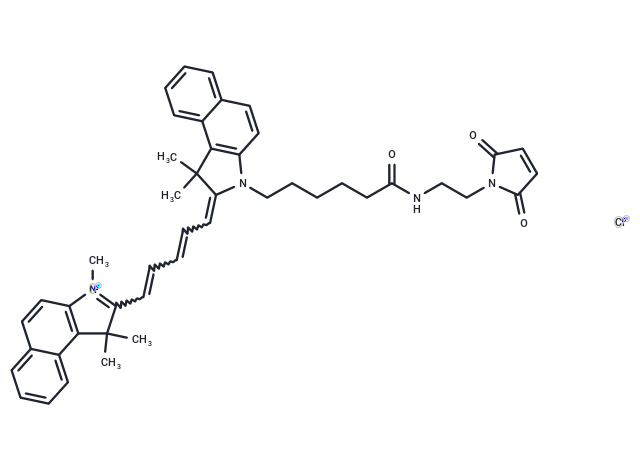Shopping Cart
- Remove All
 Your shopping cart is currently empty
Your shopping cart is currently empty

Cyanine5.5 maleimide chloride, a CY dye, is a compound characterized by two nitrogen atoms connected by an odd number of methyl units. CY dyes exhibit long wavelengths, adjustable absorption and emission, high extinction coefficient, good water solubility, and relatively simple synthesis [1]. They are commonly used for labeling proteins, antibodies, and small molecules. For protein antibody labeling, the combination can be achieved through a simple mixing reaction, which has reference significance [2].

| Pack Size | Price | Availability | Quantity |
|---|---|---|---|
| 10 mg | Inquiry | Inquiry | |
| 50 mg | Inquiry | Inquiry |
| Description | Cyanine5.5 maleimide chloride, a CY dye, is a compound characterized by two nitrogen atoms connected by an odd number of methyl units. CY dyes exhibit long wavelengths, adjustable absorption and emission, high extinction coefficient, good water solubility, and relatively simple synthesis [1]. They are commonly used for labeling proteins, antibodies, and small molecules. For protein antibody labeling, the combination can be achieved through a simple mixing reaction, which has reference significance [2]. |
| In vitro | To prepare a protein solution for optimal labeling, maintain the protein (antibody) concentration at 2 mg/mL. Ensure the solution has a pH of 8.5±0.5, and adjust with 1 M sodium bicarbonate if the pH falls below 8.0. For efficient labeling, use a final protein concentration between 2-10 mg/mL. The protein should be in a buffer free of primary amines (such as Tris or glycine) and ammonium ions to avoid affecting labeling efficiency. In preparing the dye, dilute CY dye in anhydrous DMSO to create a 10 mM stock solution, mixing thoroughly via vortex or glass tube. It is recommended to aliquot and store the CY solution at -20°C or -80°C away from light. The amount of CY dye needed for the labeling reaction depends on the protein amount, aiming for an optimal molar ratio of about 10 between CY dye and protein. For example, to label 500 μL of 2 mg/mL IgG (MW=150,000), dissolve 1 mg of CY dye in 100 μL of DMSO, which requires 3.95 μL of CY dye, calculated as follows (using CY3-NHS ester as the example): 1) mmol (IgG) = 2 mg/mL × 0.5 mL / 150,000 mg/mmol = 6.7×10^-6 mmol 2) mmol (CY3-NHS ester) = mmol (IgG) × 10 = 6.7×10^-5 mmol 3) μL (CY3-NHS ester) = 6.7×10^-5 mmol × 590.15 mg/mmol / 0.01 mg/μL = 3.95 μL (CY3-NHS ester). For the labeling reaction, gently add the calculated volume of freshly prepared 10 mg/mL CY dye to 0.5 mL of the protein sample solution, mix gently, and briefly centrifuge to collect the sample at the bottom of the reaction tube. Avoid vigorous mixing to prevent protein denaturation. Incubate the reaction tube in the dark at room temperature for 60 minutes, gently inverting the tube every 10-15 minutes to ensure complete mixing and improve labeling efficiency. For protein purification and desalting, use a Sephadex G-25 column following the manufacturer’s instructions. Load the reaction mixture onto the column, and when it reaches just below the resin surface, add PBS (pH 7.2-7.4). Complete the column purification by further adding PBS to collect fractions containing the desired dye-protein conjugates. |
| Alias | Cy5.5 maleimide chloride |
| Molecular Weight | 741.36 |
| Formula | C46H49ClN4O3 |
| Cas No. | 2409591-45-1 |
| Storage | Powder: -20°C for 3 years | In solvent: -80°C for 1 year | Shipping with blue ice. |

Copyright © 2015-2025 TargetMol Chemicals Inc. All Rights Reserved.